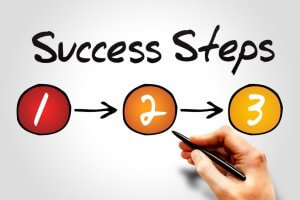Forex trading is complex, there’s no doubt about it. However, it is an absolutely fantastic opportunity to get yourself some financial freedom to get out from under that horrible boss that is holding you back and making your life hell. While it is a great opportunity, it also isn’t an easy one, if it was, there would be millions of more successful traders out there. Many people end up giving up or losing whatever it is that they have invested, this is down to the simple fact that they simply did not know what they were doing, or at least not properly. They have not had any guidance and so they do not have any obvious routes of progression.
We have come up with 10 steps that you can follow that will help guide you through the starting points of your trading journey. They are not perfect and there may be some things that you feel you want to do differently, but stick to at least a similar track, and it will make the process of learning and developing yourself as a trader a lot easier. So let’s get on with 10 steps to start your forex trading career.
Step 1: Learn everything!
Ok, so maybe not absolutely everything, that would be impossible, but you need to be willing to learn everything that you need to, which may actually turn out to be a lot more than you are expecting. If you are just starting out then you probably don’t know much about it, you probably only know what you have been told or what you have seen from the outside. There are a lot of different terms and phrases out there that will make little to no sense to you, these are things that you are going to have to learn.
Forex is a game of probabilities, many see it as gambling, you need to come in with the mentality that it is not, you are there to play the game, not to gamble. You should never place any trades without first understanding why you are placing it and what your chances are of it being a good trade. One thing that you need to understand is that you will never really complete this stage, there are always new things to learn when it comes to trading so you will be constantly learning throughout our trading career, but coming into it knowing that you are required to keep learning and to learn pretty much everything you can is a great first step.
Step 2: Get a broker
There are a lot of brokers out there, thousands if not potentially millions, so it would be unreasonable to have you look at every single one in order to work out which one is right for you. As you were going through the first step, you most likely would have come across a number of different brokers In an ideal world you would go with one of the more trustworthy and well-known brokers, checking reviews from independent sources and also asking any actual traders that you may know who they use. Try not to look for special offers or bonuses, instead go for one with better trading conditions and ones that others give good recommendations for, these in the long run will work out a lot better.
Step 3: Open an account
Each broker that you find will most likely have a number of different account types available, each one offering slightly different trading conditions Our favourite type of account is an #eCN account as they generally come with low spreads and if the commissions are kept low they can be a dream to trade on. As You are just starting out we would suggest opening up an account that does not have a hefty initial deposit limit, in terms of leverage, it is not too much to worry about at this point as again, you are just starting out so you do not want to over-leverage yourself. Be sure to play around with demo accounts too, try to get a demo account that does not start with a million bucks, this is not realistic, you want a demo account with a similar amount to what you would be trading live. Just bear in mind that while this is your first account, it certainly won’t be your last, so it is not the end of the world if it isn’t perfect, you can always open up another one before going live.
Step 4: Download a trading platform
Different brokers will offer different trading platforms. The most popular ones around the globe at the moment is from the MetaQuotes company, they have two platforms, the most popular MetaTrader 4 and the slightly less popular MetaTrader 5. MetaTrader 4 dominates the retail trading market and is one of the best supported by the various brokers. It also comes with tons of documentation as well as addons through the form of indicators and expert advisors (automated trading robots). Try out a couple of different platforms, but if you are really not sure, we would say to play it safe and stick with Metatrader 4 as your trading platform of choice. This is an important choice as not having a platform basically means that you cannot trade, however, much like with the accounts, it is not the end of the world if you start with one which you end up not liking, you can very easily switch to one of the other available platforms.
Step 5: Get a risk management plan
It may seem like a relatively small thing to do and it doesn’t actually take much time, but creating your risk management plan is one of the most vital things that you can do. It can be the make and break of your strategy, it is the thing that stands in the way between a small loss and a blown account. You can of course trade without one, but it is not something that pretty much anyone would recommend. The risk management plan is simply a set of rules that you have put in place to protect your account. Many people look at risking 1% to 2% of their account per trade, the risk management plan ensures that no more than this is lost with each trade, without one that 1% loss could in fact turn into a 100% loss. Try to make it in like with your own risk tolerance so things do not get too stressful for you.
Step 6: Learn to analyse the markets
This is where you can work out which trades to actually make. There are a lot of different ways to analyse the markets and each person will probably tell you differently. We are not going to instruct you on exactly how to do it, that will be up to you to learn the way that suits you, but we will give you some ideas on what to look for. Many forms of analysis will fall under one of two categories, fundamental analysis or technical analysis. Fundamental analysis is all about looking at how things like news events will move the markets, things like GDP or unemployment rates. Technical analysis is where you look at the markets as a whole, many people use indicators to gather this information, they can measure a number of different things and many traders seem to edge towards the technical analysis side of things. It is important that you go for the one that better suits you, so try out a few different techniques.
Step 7: Place some trades
Hopefully, you now have a grip of some of the basics, you have a broker, an account, and a trading platform, you also know how to do some basic analysis and have a risk management plan in place, the next thing to do is to actually place some trades. You should be doing this initially on a demo account, of course, and this is where you will really get a feel for trading. This is where you will work out what has worked for you and what has not, giving you the opportunity to change things and improve. Make sure you do not have the expectation of being able to win straight away, many go approximately a year before they have winning months, so you should be expecting something similar. Use these trades as a gauge for the level you are at, use them to improve.
Step 8: Look at trading styles
There are a number of main trading styles, the shorter-term day trading and scalping and the long term swing trading and position trading. Being able to find the one that both matches your personality but also works for the amount of time that you have to trade. Generally the shorter the trading timeframe the more time you need to be sat at the front of the computer. So if you only have a few minutes each day, scalping will not really work for you. Starting out, you are probably doing it part-time along with your job, so try out the longer-term ones initially, of course, if you have days off during the week, scalping could still work for you. Try out all four styles before deciding though, you may find that you enjoy one of the ones you otherwise thought you would not.
Step 9: Start and keep a trading journal
A trading journal is a vital bit of kit, it is basically where you write down everything that you do when it comes to trading, the trades you made as well as the ones you did not. You also include the reasons why you made it or didn’t, how long it was kept open, the profits, the losses, and more, pretty much everything. This gives you the perfect document to review when things have gone well as well as when they have not. It can tell you of your trading habits, making it easier to find the bad ones and get out of them, it can also tell you whether you are sticking to your trading rules, all very valuable information when looking to improve.
Step 10: Learn some more
We said that step one was going to be ongoing and so it is here at the end too. You will never stop learning, as soon as you think that you know everything you will be in trouble. Always consider yourself as available for learning, do not be afraid of things that you do not know, embrace them, and take on the new knowledge.
So those are out 10 steps to start forex trading. There are, of course, other things that you should be doing, but those will become apparent as you go along. Follow the steps above and you’ll get off on the right foot for when you decide to start your trading career.





